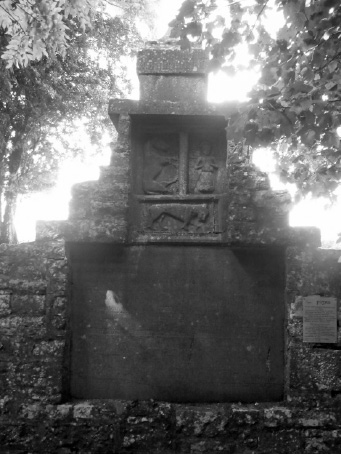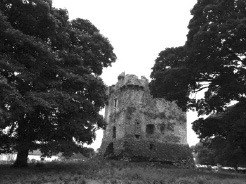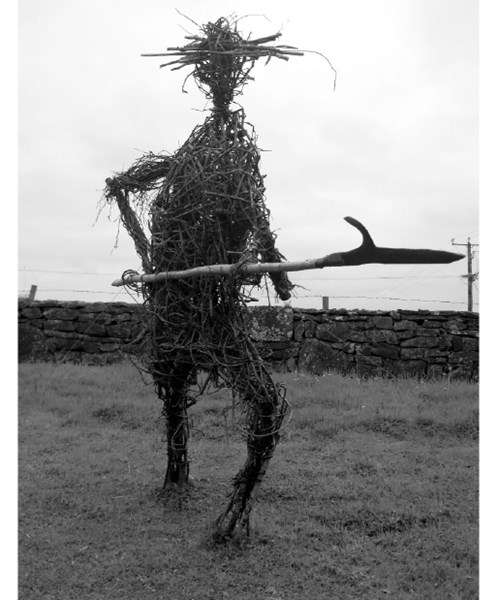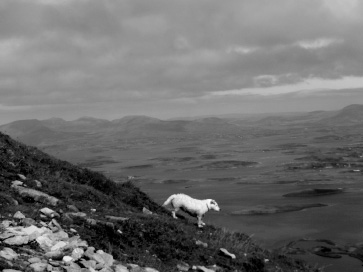Drowned drumlins swarmed in the brilliant bay, and ravens like those that plagued Saint Patrick croaked from the chasm below my feet as they rolled lazily half a mile above County Mayo. The ravens’ harsh call was an onomatopoeic reminder of my present eminence, Croagh Patrick, the 2,510-foot cone that dominates the great inlet of Clew Bay—not Mayo’s highest mountain, but indubitably its most famous, as a focus for reverence for 5,000 years, but especially since a.d. 441.
It was then, Hibernian hagiography claims, that an expatriate Welshman ascended this quartzite landmark, then called Cruachan Aigle (Eagle Mountain), to fast for 40 days and nights—and it was while he was here, beset by demons in the guise of blackbirds, that he stood on the edge of this same abyss and rang his fabled Bell to banish all venomous beasts from Ireland and win God’s promise that, as Caxton Englished it in The Golden Legend, “none Irish man shall abide the coming of the Antichrist.”
If he really did essay this ascent, like me he probably paused a quarter of the way up, then a third of the way up, then was grateful for the relative ease of the “saddle” that succeeds the first steep phase—before turning to the arduous last slope, with the loose scree scraping and sliding beneath his feet, threatening to precipitate him face-first onto unforgiving edges, or perhaps roll him right down the jagged sides and out into air. Unlike me, he probably paused for prayer, or muttered sotto voce sacred texts—like the trio of elderly men I overtook, toiling knee-clickingly upward to make what looked like it might be their final peace with their personal and national saint.
The pilgrims’ way was surprisingly busy compared with the rest of this echoing county—although not as busy as on the final Sunday in July, the annual pilgrimage of Reek Sunday—“The Reek” being the locals’ respectful nickname for this mountain, where fog frequently descends in seconds, misleading pilgrims into physical if perhaps not spiritual peril. There were many solitary walkers like me (if you exclude Skitter, my Jack Russell bitch who will follow me, but that day sometimes seemed to wonder whether she’d made the right decision), and I exchanged expressions of sweaty solidarity with people from Ireland, England, France, Germany, Spain, America, and Australia. I met a Dubliner making her 35th ascent, and a local who climbs the Croagh every Christmas Day. There were few overtly devout climbers, but there was little doubt that most saw the mountain as being in some way above the mean sea level of life.
So they should, because even the most profane, the most lost, must marvel at the panorama from the top on such a day as that one. Standing with your back to the little white chapel erected with great difficulty in 1905, you feel you command the West.
Look north, and there is Clew Bay, Thackeray’s “miracle of beauty,” studded with an  enchanted archipelago of low sandy islets stoss-ended to the sea, and stains of varying blues where deep pools suddenly cede to shallows or shifting sandbars and back again. This was the ancestral domain and natural habitat of “Granuaile” (or Grace) O’Malley, “Ireland’s Pirate Queen,” around whom nationalist and now feminist myths cling like kelp to a keel. She was a beneficiary of the greater freedom for women allowed under Brehon Law, and some of the stories are almost certainly untrue, but she was clearly a woman of extraordinary character. Born circa 1530, she was the brave and cunning representative of an ancient sept of freebooters called “lions of the green sea” by a 15th-century versifier. She captained warships, preyed on shipping from Stornoway to Finisterre, vanquished Barbary corsairs, captured and defended castles, made advantageous marriages, avenged herself murderously on enemies, fought the English invaders, and in 1593—despite being officially described as “nurse to all rebellions for forty years” and “a director of thieves and murderers at sea”—sailed her own ship from Clew to Greenwich and stood bravely before Elizabeth to ask that the English Lord President of Connaught liberate her sons and brother, and restore her property. No official record of this meeting between two such mold-breaking women has survived, so tradition has confabulated the encounter—that Granuaile towered over Elizabeth, that she was barefoot, that she refused to bow, that they conversed in Latin, and that she offended against palace protocol by showily discarding a handkerchief she had been given personally by the Queen. Elizabeth agreed to her entreaties, but only after exacting a promise from Granuaile that “she will fight in our quarrel with all the world”—a promise that rather undercuts Irish nationalist romance.
enchanted archipelago of low sandy islets stoss-ended to the sea, and stains of varying blues where deep pools suddenly cede to shallows or shifting sandbars and back again. This was the ancestral domain and natural habitat of “Granuaile” (or Grace) O’Malley, “Ireland’s Pirate Queen,” around whom nationalist and now feminist myths cling like kelp to a keel. She was a beneficiary of the greater freedom for women allowed under Brehon Law, and some of the stories are almost certainly untrue, but she was clearly a woman of extraordinary character. Born circa 1530, she was the brave and cunning representative of an ancient sept of freebooters called “lions of the green sea” by a 15th-century versifier. She captained warships, preyed on shipping from Stornoway to Finisterre, vanquished Barbary corsairs, captured and defended castles, made advantageous marriages, avenged herself murderously on enemies, fought the English invaders, and in 1593—despite being officially described as “nurse to all rebellions for forty years” and “a director of thieves and murderers at sea”—sailed her own ship from Clew to Greenwich and stood bravely before Elizabeth to ask that the English Lord President of Connaught liberate her sons and brother, and restore her property. No official record of this meeting between two such mold-breaking women has survived, so tradition has confabulated the encounter—that Granuaile towered over Elizabeth, that she was barefoot, that she refused to bow, that they conversed in Latin, and that she offended against palace protocol by showily discarding a handkerchief she had been given personally by the Queen. Elizabeth agreed to her entreaties, but only after exacting a promise from Granuaile that “she will fight in our quarrel with all the world”—a promise that rather undercuts Irish nationalist romance.
On the far side of Clew is piled the Nephin Beg Range—bleak, boggy, brown, acidic, infertile, impoverished, but enameled with loughs and gleams of improbable green, hinting at past productivity. Five-and-a-half millennia ago, Stone Agers tilled the Céide Fields before they turned into turf, depositing everyday household goods as simple as they are sculptural, as observed by much-missed Seamus Heaney in “Belderg”:
One-eyed and benign
They lie about his house,
Quernstones out of a bog.To lift the lid of the peat
And find this pupil dreaming
Of neolithic wheat!
Céide constitutes the largest Stone Age site in the world, attesting to an intensity of agricultural activity difficult to reconcile with today’s unfruitful acres.
In recent centuries, Mayo has been at times a byword for poverty, and a stronghold of nationalist resentment and Land League activism. The word boycott derives from Captain Boycott, agent for an absentee landlord, whose 1880’s attempts at gathering rents and evicting nonpaying tenants at a time of great hardship led to his utter ostracism. The county’s motto Críost Linn (Christ, help us) has a despairing as well as a devotional quality. A graphic reminder of still-bitter harvests is John Behan’s Famine Monument between the foot of Croagh Patrick and the shell of the O’Malleys’ Murrisk Abbey—a landlocked bronze three-master without sails but rigged with interlinked skeletons, a reproachful remembrance of one of England’s unfinest hours.
These fossilized fields slant down northward to one of the loneliest roads in Europe, a cheval-de-frise of cliffs and, to the northwest, a drunkenly dented coast, along which nine of Philip II’s ships foundered, ill equipped like the rest of that misbegotten expedition, relying on outdated charts and at the mercy of the untrammeled Atlantic. They could have lain securely at anchor at Broad Haven or Blacksod Bay in the lee of Belmullet, had their captains known these existed, but instead they were doomed to ride out the storms for what must have seemed like an eon, standing out from the land like the swan-semblanced Children of Lir, knowing that, if they came to the shore, they would die.
A later incursion would be briefly more successful: 1798’s “Year of the French,” when General Humbert took round-towered Killala, dashed down its bay past the curlew-cried, seaweed-stained remains of Moyne and Rosserk friaries and still-used holy wells, defeated the British garrison at Castlebar so spectacularly that the debacle was dubbed “The Races of Castlebar,” and announced a “Republic of Connacht” that lasted a dozen days before the English General Lake drowned it. Beyond Killala Bay lie the Ox Mountains, bordering on the Yeats brothers’ dreamily delineated Sligo, and beyond that again an azure suggestion of Donegal.
Look east, the direction Patrick presumably looked most frequently, and today there is tiny, tidy Westport, an incongruous urban appendage to the Augustan Westport House, home to the Marquesses of Sligo then and now. Beyond this pocket Palladianism stretch the “plains of the yew tree” (Maigh Éo), which give this mostly mountainous county its unlikely name; the English expropriators who brusquely “shired” the nine Norman-Irish baronies were heedless of toponymy, and simply named their new toy after a tiny hamlet in the county’s east that was one of the first places they came to. But the county identity has by now embedded itself, as when we were there almost every house and car seemed to have sprouted the red-and-green checkerboard and county crest in honour of Mayo’s strong showing in the Gaelic Athletic Association championships—a shield surrounded by yews, divided by a bar sinister, green hills and crosses above, below a small ship (perhaps an homage to Granuaile) riding on white water.
is tiny, tidy Westport, an incongruous urban appendage to the Augustan Westport House, home to the Marquesses of Sligo then and now. Beyond this pocket Palladianism stretch the “plains of the yew tree” (Maigh Éo), which give this mostly mountainous county its unlikely name; the English expropriators who brusquely “shired” the nine Norman-Irish baronies were heedless of toponymy, and simply named their new toy after a tiny hamlet in the county’s east that was one of the first places they came to. But the county identity has by now embedded itself, as when we were there almost every house and car seemed to have sprouted the red-and-green checkerboard and county crest in honour of Mayo’s strong showing in the Gaelic Athletic Association championships—a shield surrounded by yews, divided by a bar sinister, green hills and crosses above, below a small ship (perhaps an homage to Granuaile) riding on white water.
Beguilements beckon in the blue blur that way—Ballina’s historic document archive; the River Moy, famous for salmon; Lough Conn, for pike; Foxford, for weaving; and Knock, with its basilica and airport, prosaic and ugly, but built for magical purposes: to bring believers to view the church gable end on which apparently, one rainy August evening in 1879, the Virgin, Saints John and Joseph, and sundry seraphs disported themselves for two hours before the awed eyes of 15 villagers of unimpeachable respectability. Then the highway quits the county, unravels through lowlands and bridges the Shannon, rolling via counties Longford, Roscommon, Westmeath, Meath, and Kildare, all the way to Dublin.
Look southward, then, from the top of the mountain, to see the Sheefry Hills (“Hills of the Wraith”), the Mweelrea, Partry, and Maamturk Mountains, and, as if these were not elevations enough, behind them all Connemara’s Twelve Pins—every peak with its own stories and significance, every sedge-fringed lough holding its own lurking beast. In between are spry sheep quartering springy heather, and the dark stripes of turbary, where generations with slanes have sliced away oblongs of turf to dry in mounds, eventually to lend the Irish winter air that most characteristic of Erse odors—sweet smoke on the edge of ice.
Acting as reservoirs for all the rain runoff are lovely Loughs Mask and Corrib, linked by a canal that took five years to build, but whose limestone bed could not hold water and whose dry trench survives as a monument to engineering ineptitude. Along the adjacent Castlebar-Galway road is Ballintubber Abbey, a stripped-down barn of a place set off by roofless cloisters and powerfully suggestive 1960’s Stations, which takes pride that it has celebrated Mass every day since its foundation by a 13th-century king of Connacht—notwithstanding fires, the Reformation, Cromwell, and the notorious Seán na Sagart (John of the Priests), an 18th-century ne’er-do-well who avoided being hanged for horse theft by becoming a sniffer-out of Roman Catholic clergy who had not taken the Oath of Abjuration. He received a sum for each he entrapped or killed, ranging from ten pounds for a teacher to a hundred pounds for a bishop. It was said he would feign serious illness, and then draw a knife on priests who came to administer the Last Rites.
Unsurprisingly, after a short career he was murdered, and interred in unconsecrated ground hereabouts. There is a very unhealthy yew in the graveyard with his name affixed to it, but whether one thinks the tree’s nickname came before its sickness or the other way around depends on one’s credulity.
Along that same road is another remarkable monument, unsignposted, brooding under trees near the shell of a Georgian mansion in a waste of luxuriant grass—“The Gods of the Neale,” a whimsical 1753 limestone confection, against which local yahoos have smashed dozens of bottles. There are three small medieval panels—a unicorn, a saint, and a lion—set on a massy, mossy plinth with an inscription that is being erased by time and epiphytes, but whose meaning would have been obscure even when newly cut. The legible fragments combine elements of antiquarianism, mythology, and a coded numbering system—
“ . . . impower that in this cave we have by us the Gods of Conns Boro . . . let us follow their stepps of love with full Confidence . . . these Images were found in a cave behind the Place they now stand and were the ancient Gods of the Neale . . . AM 2577 PD 927 TC 1496 2994 AD . . . ”
—and much more in similarly Da Vinci Code vein. Seen under the darkness of the trees with the sun streaming from behind, the smell of damp earth, and with that dangerous carpet of shattered glass, it is oddly powerful for what had been simply an example of Garden Gothick, contemporaneous with the follies and fake ruins erected by the score in England by aristocrats anxious to alleviate the “Age of Reason.”
That same road barrels south through the legendary Plain of Moytura—where, according to epic, Nuada’s Tuatha Dé Danann fought Sreng’s Fír Bolg to an honorable truce—to Cong, on the border with Galway. Cong has never forgotten the visit of John Wayne to make The Quiet Man (the film crew also brought the town its first electricity), but it is even more notable for its ecclesiastical history, harking back to the alliterative 7th-century saint Fechin of Fore, the 12th-century Cross of Cong (one of the chief treasures of the National Museum in Dublin), and the redolent refounding of the abbey that same century by Roderick O’Connor, last king of all Ireland, who died there in 1198. Some of his crisply carved cloisters survive, and there is a grand avenue of yews sweeping to the pellucid Corrib, where monks would angle from the extant fishing house, and doubtless look over at the densely wooded demesne on the far bank.
There is more melancholia at nearby Shrule, also on the border. Its being on the border mattered because it marked the limits of the authority of Lord Mayo (a diminished descendant of Grace O’Malley), who had guaranteed the safe conduct to Galway City of a hundred gentry and clergy who had surrendered to the Confederate Catholics when they took Castlebar in 1641. As the refugees reached the aptly named Black River, they were set upon without warning, and almost all were massacred. The shouts of Gaelic football fans spilling out onto the road from the overflowing pub seemed to echo with sad significance, as if they were somehow channeling ancient shouting. The Clanrickard castle opposite still looks as uncompromising now as it must have then, although ivy is slighting it, cattle rub itchy flanks against its sides, and when you stand inside the dung-carpeted bastion and look up there is no roof—just warm damp fizzling down and mountain ash saplings living up to their name, rooted in crevices 40 feet above the ground.
Finally then, turn and look west from the Croagh, the Celts’ favorite direction,  where suspended spray catches all light and throws it back as an effervescent curtain that shimmers with ozone and islands. This is a vista that has always captivated, from the pre-Christians who descried the shining continent of Hy Brasil on the verge of vision, to Saint Brendan the Navigator, who saw the horizon as a veil to be pierced, and painters like Paul Henry, who lived over there on hulking Achill Island—dashing out-of-doors between downpours to observe how Ireland’s fitful Phoebus plays on the peatlands, stripes the sands, and colors the cliffs, accentuates the outlines of abandoned houses, and gleams on the backs of basking sharks patrolling for krill in Keem Bay.
where suspended spray catches all light and throws it back as an effervescent curtain that shimmers with ozone and islands. This is a vista that has always captivated, from the pre-Christians who descried the shining continent of Hy Brasil on the verge of vision, to Saint Brendan the Navigator, who saw the horizon as a veil to be pierced, and painters like Paul Henry, who lived over there on hulking Achill Island—dashing out-of-doors between downpours to observe how Ireland’s fitful Phoebus plays on the peatlands, stripes the sands, and colors the cliffs, accentuates the outlines of abandoned houses, and gleams on the backs of basking sharks patrolling for krill in Keem Bay.
Just a few days previously, I, too, had wandered on Achill, oblivious to time, and picked up as a souvenir a sheep’s skull on a shingle bank above a beach hemmed in by hills—ancestor to the animals that prospect year-round between land and Atlantic, beige as the bones of the island, printing their precise hooves between names and dates spelled out in stones by vainer visitors. On a slope near the deserted village of Slievemore stands a megalithic chamber tomb, from some angles difficult to distinguish, but from the front unmistakable and uncompromising, a quartzite container for someone who was once worth taking such trouble for, but who has long since been taken up as numinous vapor. A new house nearby, ugly as all new Irish houses are ugly, offers “emotional release therapy,” a concept rendered ridiculous by the tomb’s mystery and melancholy, the soft sound of the breeze soughing over rock, the sharp smell and gentle grumblings of sheep, and a hillside that tumbles past twitching bog-cotton to a misty impression of inlets and islets. Yet ecstatic escapes of all kinds are a natural tribute to this ensorcelled ultrawest, where epic and history, fable and fact, blend and bleed to the touch, and everything seems somehow subordinate to the massiveness and mystery of land and sea stretching forward and back forever.
[Images-First:The “Gods of the Neale”; Second: Shrule Castle; Third: Willow pikeman at Killala.]
Image Credit: Skitter, on the Croagh.

Leave a Reply